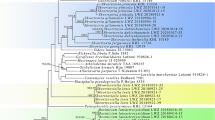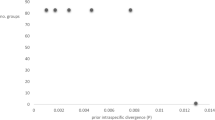Summary
Ganoderma resinaceum Boud. is a cosmopolitan wood decay fungus growing as well in temperate as in tropical climates, but most recent descriptions using the modern tools of conventional taxonomy were carried out essentially on specimens collected in the northern hemisphere and rarely from tropical Africa where previous studies were most often based on a very limited number of specimens. A thorough investigation of the thus far largest number of specimens of G. resinaceum collected in several countries of tropical Africa shows some striking variations in the macro- and microscopic features of this species compared to descriptions of specimens from temperate regions. This macro- and micromorphological diversity of tropical specimens of G. resinaceum is described and illustrated in colour for more accuracy in the taxonomy and a better knowledge of this cosmopolitan species.






Similar content being viewed by others
References
Adaskaveg, J. E. & Gilbertson, R. (1986). Cultural studies and genetics of sexuality of Ganoderma lucidum and G. tsugae in relation to the taxonomy of the G. lucidum complex. Mycologia 78: 694 – 705.
Boudier E. J. L. (1889). Etude descriptive d’une nouvelle espèce de Ganoderma de France: Ganoderma resinaceum sp. nov. Bull. Soc. Mycol. France 5: 72.
Bresadola, J. (1890). Fungi kamerunenses. Bull. Soc. Mycol. France 6: XXXII – XLIX.
Campoamor, J. N. & Telleria, M. T. (2002). A preliminary study of Polyporales and poroïd Hymenochaetales from Equatorial Guinea. IMC7. Book of Abstract of the 7th International Mycological Congress, Oslo. p. 147.
Chang, S. T. & Buswell, J. A. (1999). Ganoderma lucidum (Curt.; Fr.) P. Karst. (Aphyllophoromycetideae). — A mushrooming medicinal mushroom. Int. J. Medicinal Mushrooms 1: 139 – 146.
Corner, E. J. H. (1983). Ad Polyporaceas I. Amauroderma and Ganoderma. 182 S. mit 31 einfarbigen Abbildungen im Text. Beih. Nova Hedwigia N° 75.
Donatini, B. (1999). Les vertus médicinales des champignons. Edts Gamma. France.
Furtado, J. S. (1965). Relation of microstructure to the taxonomy of the Ganodermataceae (Polyporaceae) with special reference to the structure of the cover of the pilear surface. Mycologia 57: 688 – 711.
_____ (1967). Some tropical species of Ganoderma (Polyporaceae) with pale context. Persoonia 4 : 379 – 389.
Gonzalez, A. G., Leon, F., Rivera, A., Padron, J. L., Gonzalez-Plata J., Zuluaga, J. C., Quintana, J., Estevez, F. & Bernejo, J. (2002). New lanostanoids from the fungus Ganoderma concinna. J. Nat. Prod. 65: 417 – 421.
Gilbertson, R. L. & Ryvarden, L. (1986). North American Polypores, Vol. 1. Abortiporus–Lindtneria. Fungiflora, Oslo.
Gottlieb, A. M. & Wright, J. E. (1999). Taxonomy of Ganoderma from southern South America subgenus Ganoderma. Mycol. Res. 103: 661 – 673.
Hajjaj, H., Mace, C., Roberts, M., Niederberger, P. & Fay, L. B. (2005). Effect of 26 – oxygenosterols from Ganoderma lucidum and their activity as cholesterol synthesis inhibitor. Appl. Environm. Microbiol. 71 (7): 3653 – 3658.
Härkönen, M., Niemela, T. & Mwasumbi, L. (2003). Tanzanian mushrooms. Edible, harmful and other fungi. Norrlinia 10: 1 – 200.
Hjortstam, K., Ryvarden, L. & Watling, R. (1993). Preliminary checklist of non-agaricoid macromycetes in the Korup National Park, Cameroon and surrounding area. Edinburgh J. Bot. 50 (1): 105 – 119.
IUCN (2001). IUCN Red List, Categories and Criteria, Version 3.1. Prepared by the IUCN Species Survival Commission. IUCN, Gland & Cambridge.
Jahn, H. (1990). Pilz an Bäumen. Patzer Verlag, Berlin. Hannover.
Kinge, T. R. (2012). Basal Stem Rot Disease of Oil palm and Identification of species of Ganoderma in South Western Cameroon. Ph.D thesis, University of Buea, Cameroon.
____ & Mih, A. (2011a). Ganoderma ryvardense sp. nov. associated with basal stem rot (BSR) disease of oil palm in Cameroon. Mycosphere 2 (2): 179 – 188.
____ & Mih, A. (2011b). Secondary metabolites of oil palm isolates of Ganoderma zonatum Murrill. from Cameroon and their cytotoxicity against five human tumour cell lines. African J. Biotechnol. Vol. 10 (42): 8440 – 8447.
Kornerup, A. & Wansher, J. H. (1978). Methuen handbook of colour. 3rd Edn. Eyre Methuen, London.
Li, Y., Yang, Y., Fang, L., Zhang, Z., Jin, J. & Zhang, K. (2006). Anti-hepatitis activities in broth of Ganoderma lucidum supplemented with a chinese herbal medicine. Amer. J. Chin. Med. 34 (2): 341 – 349.
Ling-Chie Wong, Choon-Fah J. Bong & Idriss, A. S. (2012). Ganoderma Species Associated with Basal Stem Rot Disease of Oil palm. Amer. J. Appl. Sci. 9 (6): 879 – 885.
Moncalvo, J. M. (2000). Systematics of Ganoderma. In: J. Flood, P. D. Bridge & M. Holderness (eds), Ganoderma Diseases of perennial Crops, pp. 23 – 45. CAB International, Wallingford.
____& Ryvarden, L. (1997). A nomenclatural Study of the Ganodermataceae Donk. Syn. Fungorum 11.
____, Wang, H. & Hseu, R. S. (1995). Phylogenetic relationships in Ganoderma inferred from the internal transcribed spacers and 25S ribosomal DNA sequences. Mycologia 87(2): 223 – 238.
Morigiwa, A., Kitabatake, K., Fujimoto, Y. & Ikekawa, N. (1986). Angiotensin converting enzyme-inhibitory triterpenes from Ganoderma lucidum. Chem. Pharmacol. Bull. (Tokyo) 34: 3025 – 3028.
Mossebo, D. C. (2005). Contribution à la connaissance de la flore mycologique tropicale: Inventaire, taxonomie et systématique des collections de Basidiomycètes (Macromycètes) du Cameroun et d’Afrique centrale. Mémoire d’Habilitation à Diriger des Recherches (HDR), Université de Lille 2.
____, Kengni Ayissi, M. B. & Ambit, R. T. (2014). New taxa and potential pharmacological properties of some Ganodermataceae (Basidiomycota) from Cameroon and central Africa. In abstracts book (Scripta Bot. Belg. 52, 291) of the Proceedings of the XXth AETFAT Congress, Stellenbosch, South Africa, 13th –17th January 2014.
____, Njouonkou, A. L., Courtecuisse, R. & Amougou A. (2007). Enzymatic activities and decay characteristics in some wood-rotting Basidiomycetes from Cameroon and determination of the time-dependant activity of syringaldazine in spot tests. Cryptog. Mycol. 28 (2): 107 – 121.
____ & Pegler, D. N. (1998). Psathyrella yaoundeana sp. nov. (Agaricales, Coprinaceae) from Cameroon. Kew Bull. 53: 1001 – 1003.
____ & Ryvarden, L. (1997). Fomitopsis africana sp. nov. (Polyporaceae, Basidiomycotina). Sydowia 49 (2): 147 – 149.
____ & ____ (2003). The Genus Mycorrhaphium in Africa. Mycotaxon 88: 229 – 232.
Mothana, R. A., Jansen, R., Julich, W. D. & Lindequist, U. (2000). Ganomycins A and B, new antimicrobial farnesyl hydroquinones from the Basidiomycete Ganoderma pfeifferi. J. Nat. Prod. 63: 416 – 418.
Njouonkou, A. L., Mossebo, D. C. & Amougou, A. (2013). The genera Lentinus and Panus in the Dja Biosphere Reserve and its periphery, Cameroon. Kew Bull. 68: 517 – 521. DOI 10.1007/S12225-013-9461-1
Oyetayo Olesegun, V. (2011). Medicinal uses of mushrooms in Nigeria: towards full and sustainable exploitation. Oyetayo Afr. J. Tradit. Complement Altern Med. 8 (3): 267 – 274.
Phillips, R. (2006). Mushrooms. A comprehensive guide with over 1250 detailed photographs of mushrooms and other fungi. Pan MacMillan Ltd., London.
Raponda, W. & Sillans, R. (1995). Les plantes utiles du Gabon. Edt. Sépia.
Roberts, P. & Ryvarden, L. (2006). Poroid fungi from Korup National park, Cameroon. Kew Bull. 61: 55 – 78.
Ryvarden, L. (1985). Type studies in the Polyporaceae. 17. Species described by W. A. Murril. Mycotaxon 23: 169 – 198.
____ (1991). Genera of Polypores; nomenclature and taxonomy. Syn. Fungorum 5.
____ (1995). Can we trust morphology in Ganoderma? In: P. K. Buchanan, R. S. Hsea & J. M. Moncalvo (eds), Proceedings of Contributed Symposium 59. Fifth International Mycological Congress, Vancouver, Canada pp. 19 – 24.
____ (2000). Studies in neotropical polypores 2: A preliminary key to neotropical species of Ganoderma with a laccate pileus. Mycologia 92 (1): 180 – 191.
____ (2004). Neotropical polypores, Part 1. Introduction, Ganodermataceae & Hymenochaetaceae. Syn. Fungorum 19.
____ & Johansen, I. (1980). A Preliminary Polypore Flora of East Africa. Fungiflora, Oslo.
____ & Gilbertson, R. L. (1993). European Polypores part 1. Syn. Fungorum 6.
Smania, A. J., Delle Monache, F., Smania, E. F. A. & Cueno, R. S. (1999). Antibacterial activity of steroidal compounds isolated from Ganoderma applanatum (Pers.) Pat. (Aphyllophoromycetidae) fruit body. Int. J. Medicinal Mushrooms 1: 325 – 330.
Smith, B. J. & Sivasithamparam, K. (2003). Morphological studies of Ganoderma (Ganodermataceae) from the Australian and Pacific regions. Austral. Syst. Bot. 16: 487 – 503.
Steyeart, R. L. (1962). Genus Ganoderma (Polyporaceae). Taxa Nova II. Bull. Jard. Bot. État. Bruxelles 32: 89 – 104.
____ (1967). Les Ganoderma palmicoles. Bull. Jard. Bot. Natl. Belg. 37 (4): 465 – 492.
____ (1972). Species of Ganoderma and related Genera, mainly of the Bogor and Leiden Herbaria. Persoonia 7: 55 – 118.
____ (1980). Study of some Ganoderma species. Bull. Jard. Bot. Natl. Belg. 50: 135 – 186.
Timo, H., Niedermeyer, J., Lindequist, U., Mentel, R., Gordes, D., Schmidt, E., Thurow, K. & Lalk, M. (2005). Antiviral terpenoid constituents of Ganoderma pfeifferi. J. Nat. Prod. 68: 1728 – 1731.
Walleyn, R. & Rammeloo, J. (1994). The poisonous and useful fungi of Africa south of the Sahara. Scripta Bot. Belg. 10: 1 – 56.
Wang, X-C., Xi, R-J., Li, Y., Wang, D-M. & Yao, Y-J. (2012). The species identity of the widely cultivated Ganoderma “G. lucidum” (Ling-zhi) in China. PLos ONE 7 (7): 1 – 14 (e 40857).
Welti, S. & Courtecuisse, R. (2010). The Ganodermataceae in the French West Indies (Guadeloupe and Martinique). Fungal Diversity 43(1): 103 – 126.
____, Moreau P. A., Azaroual, N., Lemoine, A., Duhal, N., Kouach, M., Millet, R. & Courtecuisse, R. (2010). Antiproliferative Activities of Methanolic Extracts from a Neotropical Ganoderma species (Aphyllophoromycetideae): Identification and Characterization of a Novel Ganoderic Acid. Int. J. Medicinal Mushrooms 12(1): 17 – 31.
Xue-Mei Niu, Sheng-HongLi, Wei-Lie Xiao, Hang-Dong Sun & Chun-Tao Che (2007). Two new lanostanoids from Ganoderma resinaceum. J. Asian Nat. Prod. Res. 9 (Issue 7): 659 – 664.
Zhao, J. D. (1989). The Ganodermataceae in China. Biblioth. Mycol. 132: 1 – 176.
Zhu, L. Yang & Bang, Feng (2013). What is the Chinese “Lingzhi”? — a taxonomic mini-review. Mycology 4 (1): 1 – 4
Zoberi, M. H. (1972). Tropical macrofungi. Some common species. The MacMillan Press Ltd., London & Basingstoke.
Acknowledgements
The authors are very grateful to Professor Leif Ryvarden of the University of Oslo in Norway for cross-checking our preliminary identifications of Ganoderma specimens and for his constant collaboration. We are also grateful to the Cameroon Ministry of higher education (MINESUP) for the special support fund for research, thanks to which part of the field and laboratory work was carried out.
Author information
Authors and Affiliations
Corresponding author
Rights and permissions
About this article
Cite this article
Kengni Ayissi, B.M., Mossebo, D.C. Some noteworthy taxonomic variations in the complex wood-decayer Ganoderma resinaceum (Basidiomycota) with reference to collections from tropical Africa. Kew Bull 69, 9542 (2014). https://doi.org/10.1007/s12225-014-9542-9
Accepted:
Published:
DOI: https://doi.org/10.1007/s12225-014-9542-9




